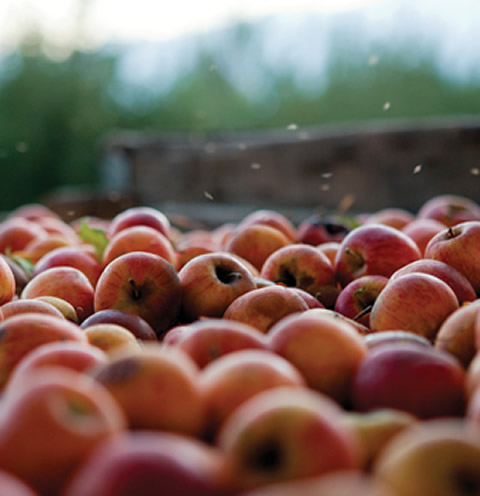Not long ago, some of the cafeterias on U of T’s St. George campus began serving meals made mostly from food grown in Ontario. The cafeterias work with Local Food Plus, an organization promoting food grown by local farmers. The goal – to reduce Canada’s carbon footprint by reducing the distance food travels – is worthy, says U of T Mississauga geography professor Pierre Desrochers, but is based on a faulty premise.
While a New Zealand apple eaten in Morrison Hall represents more “food miles” (the distance travelled from “farm to fork”) than the indigenous McIntosh – it doesn’t mean that the Ontario apple is the better environmental choice, says Desrochers. New Zealand apples are grown during our winter months so they don’t need to spend long periods in energy-guzzling cold storage, he says.
Desrochers challenges the popularity of the 100-Mile Diet in a paper published as part of George Mason University’s Mercatus Policy Series. The article has made him a virtual pariah to opponents of corporate agriculture. “The people who protest my paper circle together like muskoxen. They’re reluctant to consider the data. They’re angry at corporations but feel powerless to effect change. So they transpose their efforts to something they can relate to: food purchases.”
According to Desrochers, buying locally grown but economically uncompetitive products almost never reduces greenhouse gases. In the U.S., 80 per cent of the energy used to get food from the farm to the table occurs during food production. Transportation accounts for less than 10 per cent. He says western European consumers could reduce their greenhouse gas emissions if they bought milk solids or apples from highly efficient New Zealand producers rather than from heavily subsidized and much less efficient local producers.
“Long-distance food transportation by highly efficient diesel container ships represents only a tiny percentage of the total energy used in agricultural production,” says Desrochers, adding that cold storage or greenhouses use much more energy. “North Americans somehow forget that we have seasons.”
Desrochers says he is not against local food production. He says it works in some places, especially when the food is in season. But our ancestors shifted away from subsistence farming for good reasons – including to reduce the chance of famine. “Our modern food supply chain is a demonstrably superior alternative that has evolved through constant competition and rigorous management efficiency.”
Desrochers has no illusions of winning over the prevailing Local Food Plus faction that pronounces: Let’s go the distance so our food won’t have to.
“Until recently, my brother was a Quebec politician who represented an agricultural riding. I don’t know if I would ever be able to convince him that not buying from local producers is the right thing to do.”






No Responses to “ The Ideal Distance from Farm to Fork ”
Local Food Plus certifies farmers for both 'local' and 'sustainable' food production. The sustainable component looks at environmental sustainability in production, habitat preservation, biodiversity, animal welfare, farm labour rights and reduced GHG emissions on the farm. This article implies that LFP is only about local which is not the case. www.localfoodplus.ca
I would like to see a link to the academic article or at the very least a title. I'd love to believe that non-local food is sometimes more environmentally friendly, but I'd like to have a look at how economy of the food chain was measured and what foods were measured. A winter, seasonal food stored in a cold cellar or mudroom takes no energy to keep fresh for the cold months until produce becomes available again. Given we're keeping our diet the very same, with a mix of all seasons, all year, I'd think his paper would be very valid. If he's gone this way, it would be extremely motivating for local foodies to look at the numbers, put their money where their mouth is, and purchase only seasonal produce. One can't expect local summer produce in mid-winter.
Local produce is always better in terms of jobs, pollution, sense of community and safety (with respect to the introduction of foreign species and microbes). Cold cellars and root houses use little or no energy and canned goods keep for years.
Why must I buy canned peaches from Greece? Why is maple syrup made here in Canada cheaper in the United States? Why do I buy pork from the U.S. when we produce pork here?
Products from every country are circling the glode because of corporate brainwashing - or some professor's idea that it is more viable to eat apples from New Zealand in the winter here in Canada. Those tankers may be efficient but you need to distribute the product once it gets here.
Let's evaluate all the factors in food consumption and production to get a real answer.